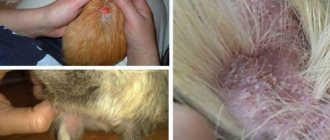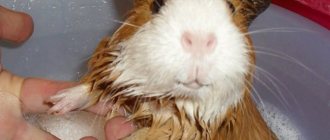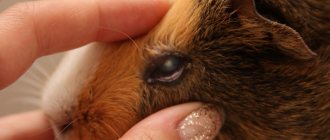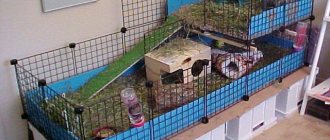Parasites in guinea pigs - both external (ectoparasites) and internal (endoparasites) - are acquired mainly due to improperly organized maintenance or care. But even timely cleaning of the cage in compliance with all the rules and the absence of walks outside the habitat do not completely protect pets from parasites. There are many options for infection. Therefore, it is extremely important for the owner of the little animal not only to know and observe the peculiarities of keeping and caring for a guinea pig, but also to learn in advance how to protect the pet from infection. And also, what measures to take if the infection does overtake the animal.
Group of ectoparasites
This type includes skin types of parasites. The most common are skin lice, fleas and lice. The first symptoms of a pet infection include redness and itching of the skin, as well as hair loss in areas where microorganisms accumulate. It is this type of parasite that causes diseases that cause exhaustion, purulent ulcers, and in advanced cases, death. Moreover, the latter scenario can occur not only due to the animal’s lack of appetite, but also due to less obvious signs such as general blood poisoning. The fact is that toxic substances enter the blood through abrasions and microcracks formed by scratching the affected areas by the animal itself.
Prevention
Since guinea pigs become infected from other pets, all pets should be treated periodically with insecticides .
Features of the American Teddy guinea pig breed.
The cleanliness of the cell plays an important role. Regular cleaning, changing bedding, disinfecting feeders and drinking bowls are important aspects of caring for a guinea pig. The pet's home is also washed with the addition of an insecticide. The smell of the product will repel fleas and ticks.
Sources
- https://homkin.ru/morskie-svinki/zdorovie-morskih-svinok/parazity-blohi-kleshhi-vlasoedy.html
- https://combat-dez.ru/kak-izbavitsia-ot-bloh-y-morskih-svinok/
- https://msvinkam.ru/bolezni/parazity-u-morskih-svinok.html
- https://homjakam.ru/morskaya-svinka/zdorove/parazity
- https://NaLugah.ru/zhivotnovodstvo/morskie-svinki/parazity-u-morskih-svinok-simptomy-i-lechenie.html
- https://klopkan.ru/blohi/vsyo-o-blohah/blohi-u-morskih-svinok/
- https://apest.ru/nasekomye/vlasoedy/vlasoedy-u-morskih-svinok/
- https://xvostus.com/morskaya-svinka/bolezni/blohi.html
[collapse]
Fleas
Oddly enough, cat-type fleas are the most common in guinea pigs. These types of parasites can get onto an animal from anywhere, even from the owner’s skin. The symptoms of the disease are similar to the previous version: redness of the skin, itching, hair loss in the affected areas. Detecting fleas is not difficult: just comb your pet's fur thoroughly.
After thoroughly brushing your pet, it is important to check for insects between the teeth of the comb or comb. Fleas settle in the external environment (bedding, upholstered furniture, carpets); in animals they can only be detected during blood feeding. Guinea pigs become infected with these parasites from sick animals, most often dogs and cats.
The process of treating fleas itself is not so complicated, but the difficulty is that in addition to treating and monitoring the health of the sick animal, it is also necessary to monitor its environment, especially if there are small animals in the offspring. Treating the animal with topical shampoos and sprays is permissible; it is important that it contains pyrethritol. They also need to wash the cage and all accessible areas. In a couple of days of high-quality treatment of the animal, you can exterminate all pests along with their larvae.
Diseases dangerous to humans
- Strongyloidiasis,
- Giardiasis,
- Encephalitis.
Giardiasis
Symptoms of infection:
- Nausea,
- Stomach ache,
- Bloating, gas formation, constipation and diarrhea, replacing each other,
- Skin rashes
- Fatigue, increased drowsiness, loss of appetite, poor sleep and frequent dizziness.
Tick-borne encephalitis
If a guinea pig walks outdoors in the summer, it needs to wear a special anti-mite collar. Otherwise, there is a high risk that the animal will bring back a tick infected with encephalitis from a walk. This disease is dangerous not only for pigs, but also for humans.
An ignorant person, looking at an actively itching pig, is sure that this is how guinea pigs manifest themselves. But this is far from true: the most common cause of itching is one of the types - fur or scabies.
Scabies
This species is more dangerous for a “sea” pet. When it appears, the following symptoms are possible:
- the appearance of papules;
- skin redness;
- the appearance of areas with rough skin;
- hair loss.
Only a veterinarian can accurately determine the culprit. He will do this after examining a scraping taken from the animal’s skin.
Ticks
There are two types of mites on guinea pigs - subcutaneous and scabies. Each has characteristic features both in manifestation and in treatment.
Scabies type of mite
The difference between this type of mites lies in the fact that they can cause severe itching of the animal’s skin. The danger for the animal lies in the fact that not only the blood will be infected, but the animal may also die due to stress. The main symptoms of subcutaneous mite infestation include the following:
- skin itching;
- severe hair loss;
- redness and dryness of the skin;
- high temperature, chills;
- refusal to eat completely or partially.
Primary lesions in guinea pigs include the head, back, sides and shoulders. But if you do not pay attention to the problem in time, they can spread throughout the animal’s body, causing even more discomfort. It’s even worse if a pregnant female is infected with parasites. In this case, there is a risk of miscarriages and complications during pregnancy. Ticks can spread to mumps both from humans and from contact with other animals. You can only determine whether there are mites on your pet's skin using a scraping procedure. It is worth noting that treatment should apply not only to the infected animal, but also to its entire environment.
Along with the injections, it is necessary to thoroughly rinse the cage with a solution containing lime sulphide or chlorine.
Fur type mite
The difference from the previous species is that it settles, as a rule, on the surface of the skin. Symptoms of infection with the disease in an animal are similar to previous species. Only peeling of the skin is also observed. Refusal of water and restlessness of the animal are typical symptoms of a tick. If the infection is severe, painful ulcers may appear on the skin, and fur will begin to fall out at an increased rate. It is worth noting that the fur type of tick is transmitted only through direct contact between a healthy and sick animal. The treatment method is similar to the previous analogue. The room where the sick animal is located should be treated with a special anti-tick compound.
Preventive measures
Guinea pigs are susceptible to a variety of parasites that live on both their skin and fur. If you properly care for your pet and take preventive measures, the likelihood of parasitic disease will decrease.
It is recommended to treat your pet with a spray if the animal is allowed out for a walk on the lawn in the yard. Washing the cage once a week with flea shampoo will also help prevent the occurrence of parasites. The smell of the product remains and repels pests. Since ticks pose a huge danger, before going into nature it is necessary to treat guinea pigs with a special product. If the pig is in a pen, you should check the animal at least twice a day for the presence of parasites.
Particular attention should be paid to places such as the armpits, stomach and ears. Swipe through the animal's fur. If there is a tick, you will certainly feel it.
Lice
Despite the rarer occurrence of this type of parasite, they can occur even with good care of the pet. And, most dangerously, it can be transmitted to humans through contact with a sick animal. Lice cause the appearance of pediculosis, which is characterized by severe itching, obesity and increased temperature of the animal. Lice can be treated using fairly gentle methods: if the infestation is not so local, you can use specialized shampoos. Veterinarians recommend treating the animal with a 10-day course of ivarmectin just in case. The pig's cage must be washed with a solution containing chlorine. It is also necessary to shampoo all pets that have previously come into contact with the infected person.
Where do parasites come from in guinea pigs?
Furry, properly cared for pet rodents become infected with both types of parasites primarily through contact:
- with an infected animal - rodent, cat, dog, etc.;
- with hay or poor quality litter.
In addition, in the process of searching for food, parasitic insects often enter houses and apartments through sewer systems and basements. Sometimes the owner himself becomes the carrier of the infection - ectoparasites are able to hide in the clothes in which a person walked down the street. Once in housing, they switch to a pet.
lice eaters
This is another type of parasite that differs in that it can feed not only on particles of the animal’s skin, but also on its blood. Due to the small size of the parasites, it is quite difficult to detect them with the naked eye; you will have to use scraping. The first signs include hair loss of the animal, as well as itching. An animal's reduced appetite threatens death from exhaustion. The danger is that lice can get on the animal even with careful care, for example, through the owner’s clothes or toys from the store.
Comprehensive treatment measures include treating all animals that have previously been in contact with or are close to an infected individual, even if they do not show signs of infection.
Akaromectin, Bolfo and Bars spray can be used as medical assistants in the fight against lice eaters. Due to the fact that bathing is considered extremely stressful for pigs, it is best to opt for a spray, as it will cause them less discomfort. The animal does not resist the procedure and, if necessary, it must be repeated the prescribed number of times. This is usually done by a veterinarian. Lice remedies are also available in human pharmacies, but you need to choose those options that contain the substance permethrin. The largest number of breeders recommend choosing Advocate spray. Due to the content of fewer toxic substances, it is safer for the animal.
Lice eaters are localized in the croup and perineum; they parasitize at the roots of the hair, wrapping their limbs around the hair, and feed on blood, epidermal scales and secretions of the sebaceous glands. As a result, the affected hair falls out. Lice eaters are most active in winter, when the guinea pig's fur becomes thicker and longer, which is a favorable factor for the proliferation of parasites.
Lice feed on blood and are able to actively move around the animal’s body, causing itching. Parasites can be seen with the naked eye when parting the fur, mainly in the head area and around the ears.
Guinea pigs become infected with lice and lice through contact with sick relatives, through bedding and food.
Lice and lice cause itchy skin and severe anxiety in a sick animal, up to the appearance of seizures and convulsions. Fleas with intense infestation can cause inflammation of the skin - flea dermatitis. It is characterized by redness of the skin, baldness, and eczema.
Types, symptoms and treatment
As mentioned earlier, pests in guinea pigs can be external (ectoparasites) and internal - helminths and protozoa (endoparasites). Some live on the skin or fur of an animal, others have adapted to parasitize inside the body.
The most common types of ectoparasites in guinea pigs are ticks and lice, and less commonly, lice and fleas.
Subcutaneous mite
It is also called scabies mite. The infestation may come from another sick animal. This parasite causes very severe and painful itching, wounds appear on the rodent's skin from scratching and biting, and some of the hair falls out. A tick cannot be seen with the naked eye, only under a microscope. In a healthy animal with proper nutrition, the subcutaneous mite can even remain inactive for several years. However, as soon as the pig gets pregnant or gets stressed, the problem will come out.
At the veterinary clinic they take a scraping for examination, although it sometimes gives a false answer. In this case, if there are symptoms of subcutaneous mite infection, treatment is carried out for diagnostic purposes. If it gives a positive result, a full course of the drug is prescribed. For treatment can be used:
- Advocate.
- Stronghold.
- Otodectin (solution for injection).
- Ivermectin (solution for injection).
To avoid an overdose and not harm the pet, only one drug is prescribed.
lice eaters
They are a serious threat to the health of guinea pigs. They can be carriers of helminths and fungal infections. The first sign that a lice eater has settled in an animal’s fur is severe itching. The animal seems worried and often itches, causing ulcers and wounds to appear on the skin.
The parasite can be seen with the naked eye by examining the pet's fur. These are small insects up to two millimeters in length, grayish or yellowish in color (depending on the color of the rodent).
If you find a lice eater, there is no need to panic. Today there is a large selection of medicines that can cope with infection:
- Spray Frontline. It is easy to use and most often the therapeutic effect occurs after the first use.
- drops are the most effective remedy. They not only cure the pet, but also prevent the reappearance of pests. Famous brands: Bars, Green Fort, Advantage.
- Among emulsions, Neostomozan is in demand.
- Collars.
- Shampoos.
- Powder.
Fleas and lice
Fleas are more common than lice, but the latter are dangerous because they can also parasitize humans. You can find lice or fleas using a comb. Their appearance is also accompanied by: itching, hair loss and scratching on the rodent’s body. If the infection is not advanced, then treatment will not be difficult.
To get rid of fleas and lice, use a spray or shampoo for cats, which should contain pyrethritol. Both the animal itself and the cage in which it lives should be treated.
Worms
Due to the fact that the main property of this group of parasites is to absorb nutrients from the animal’s blood, this can lead to exhaustion. Typically, guinea pigs are inhabited by tape and round parasites. Worm larvae of this type are dangerous not only for the animal, but also for the owner. With severe infection, you can see not only worm larvae in the stool, but also quite adult individuals with the naked eye. The animal is characterized by lethargic behavior, drowsiness and decreased appetite. If the infection is very strong, parasites crawling out of the anus can also be seen with the naked eye.
If the infection is not severe, you can give the animal a suspension of prazicide for kittens. The amount is calculated at the rate of 1 gram per 1 kg of animal weight. Dirofen paste has a good reputation among veterinarians. When treating an animal with medications, you need to treat the cage and accessories with a chlorine-containing solution.
Carrying out diagnostics
You can identify fleas yourself. They can be seen with the naked eye on the rodent's face and stomach. If you comb the fur with a single-row, fine-toothed comb, it will leave behind insect excrement in the form of small brown clumps, as well as dead or living insects. Parasites are easier to detect on animals with light fur.
If the diagnosis is carried out by a veterinarian, he takes a scraping from the rodent's skin for examination.
A pig can have several diseases at the same time, for example:
- allergic dermatosis;
- ectoparasites;
- streptococcal infection;
- neurodermatitis;
- mycoses.
Any of these factors, as well as metabolic disorders and poor nutrition, cause itching, sore skin and hair loss.
To determine the presence of the disease, a scraping is taken from the animal's skin.











